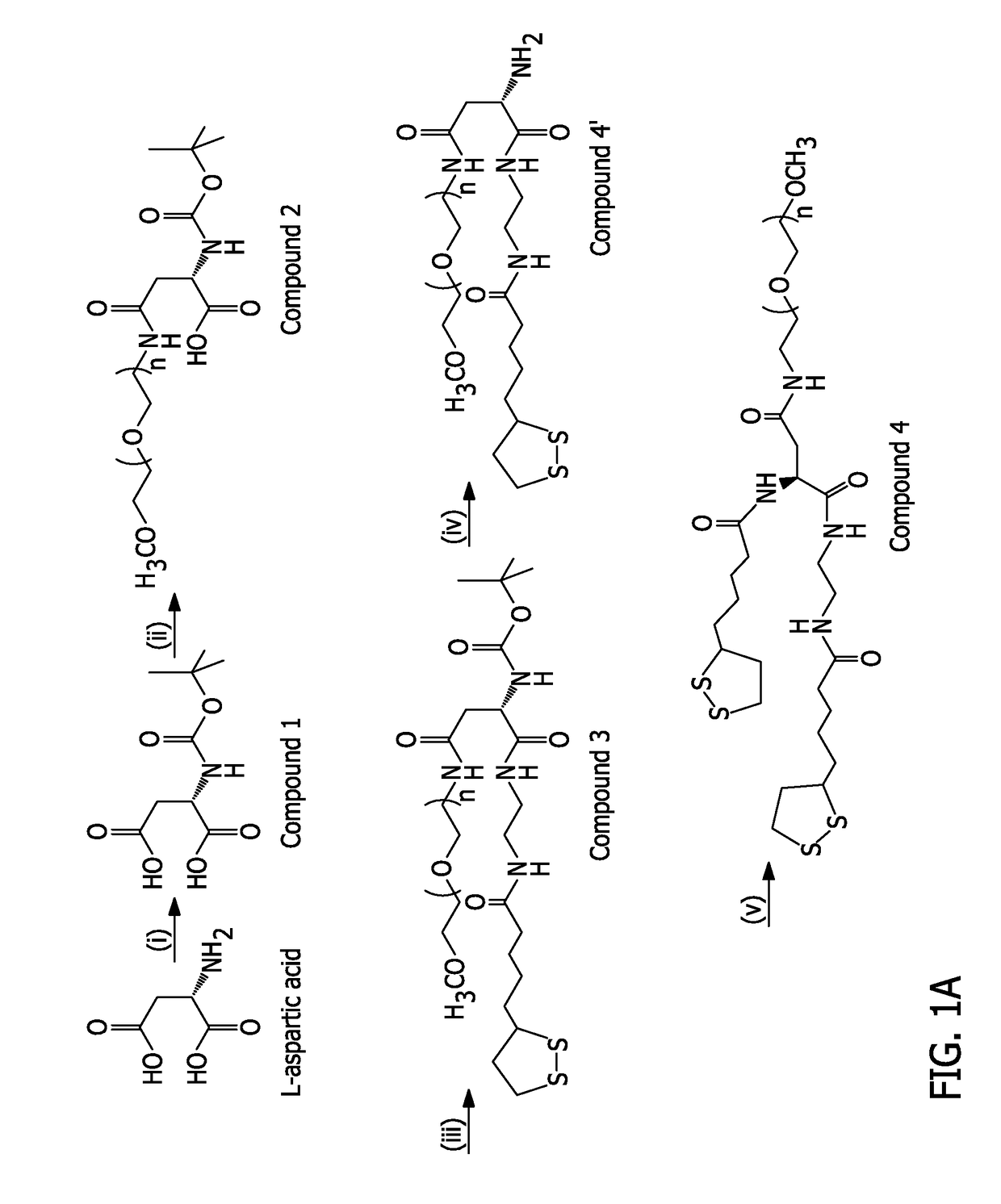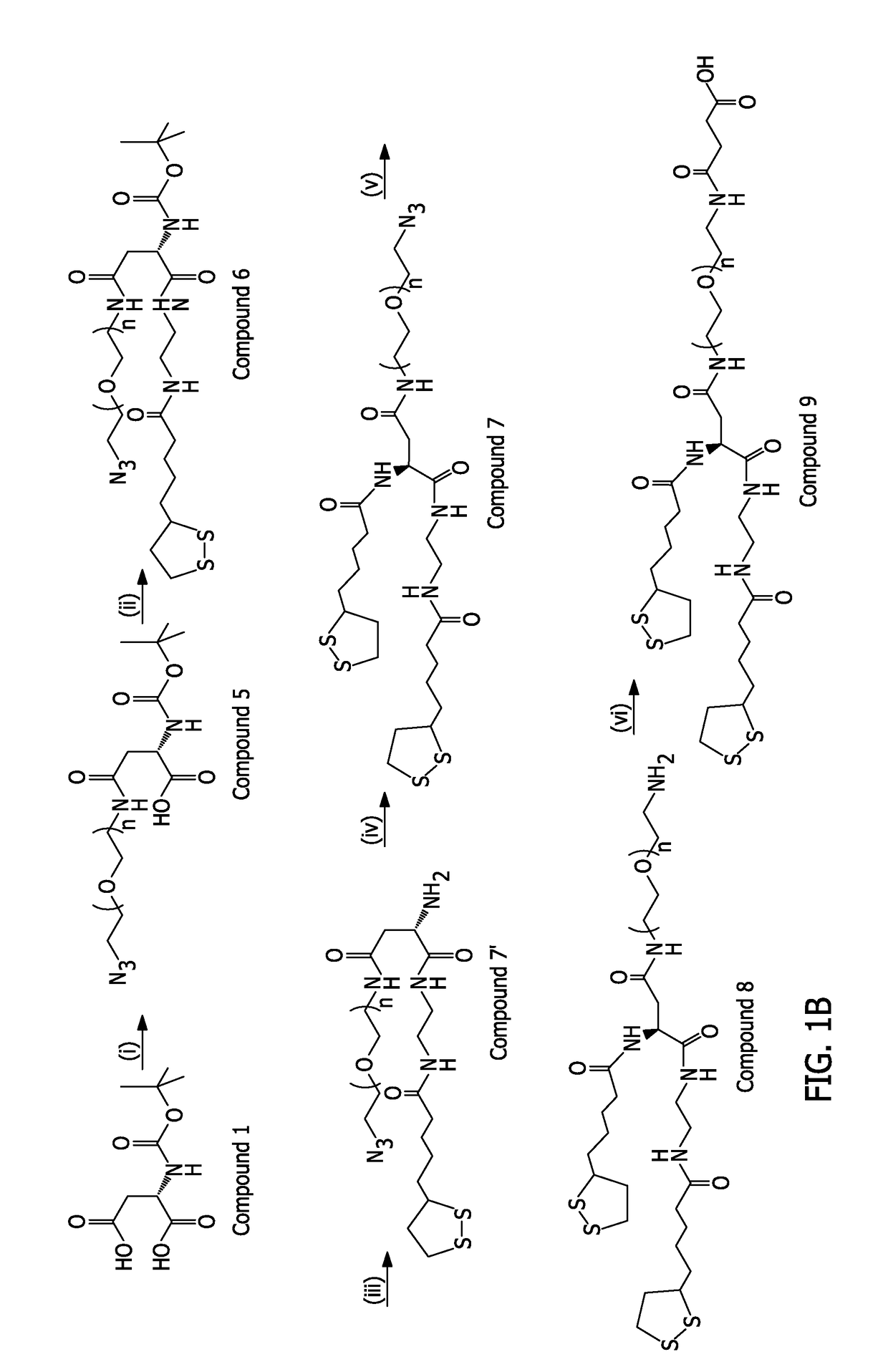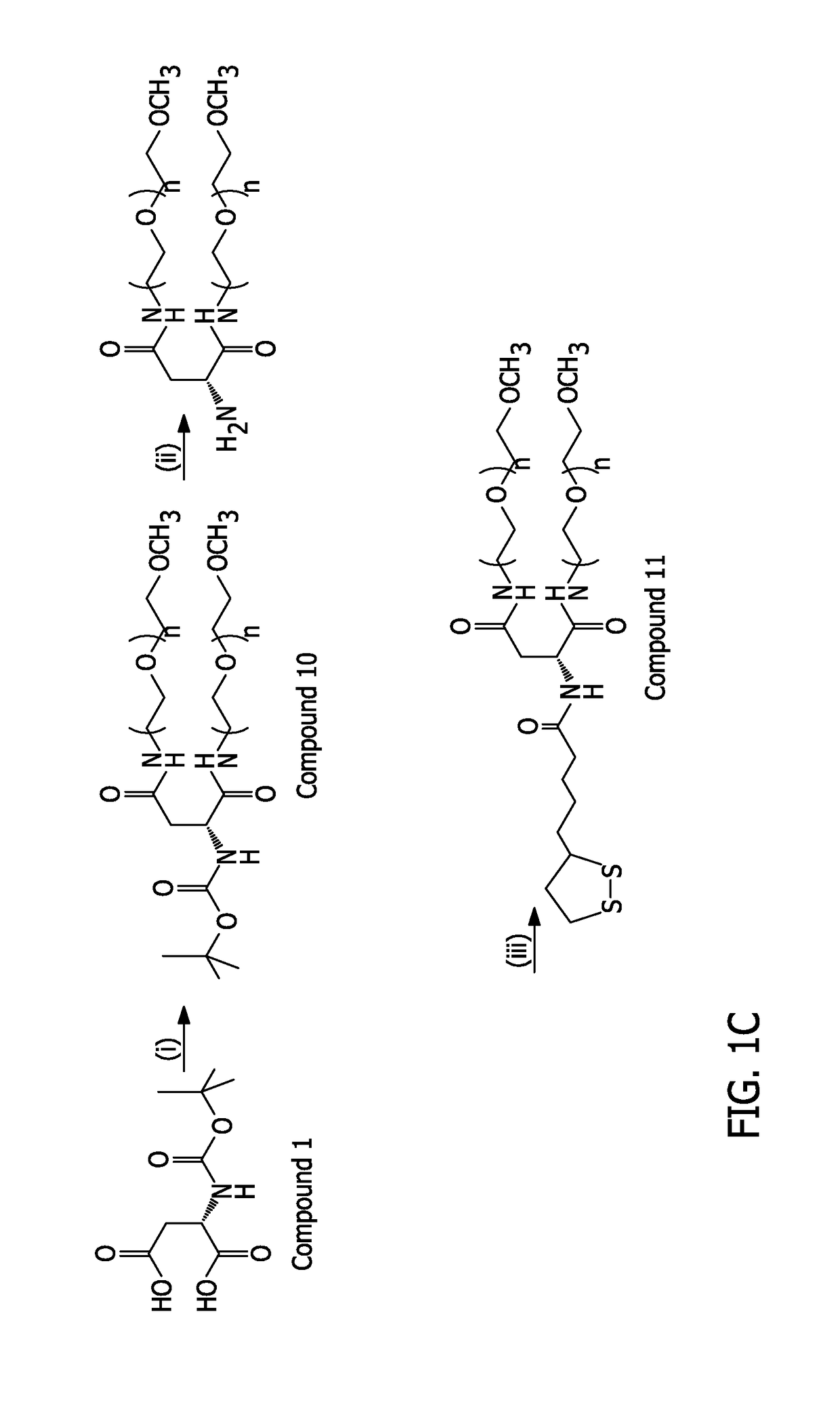Controlling the architecture, coordination, and reactivity of nanoparticle coating utilizing an amino acid central scaffold
a nanoparticle coating and central scaffold technology, applied in the direction of luminescent compositions, instruments, organic chemistry, etc., can solve the problems of limited ability to integrate biomolecules, or introduce them into live cells, versatility and scalability of synthetic schemes, etc., to facilitate intracellular uptake, improve resistance to nacn digestion, and excellent stability
- Summary
- Abstract
- Description
- Claims
- Application Information
AI Technical Summary
Benefits of technology
Problems solved by technology
Method used
Image
Examples
example 1
tal Section
[0197]Materials.
[0198]Poly(ethylene glycol) with molecular weight 600 and 1000 were purchased from Acros Organics (Morris Plains, N.J.). Poly(ethylene glycol) methyl ether (molecular weight of 750), aspartic acid, lipoic acid (LA), N,N-dicylohexylcarbodiimide (DCC), 4-(N,N-dimethylamino)pyridine (DMAP), di-tert-butyl dicarbonate (Boc2O), triphenylphosphine, succinic anhydride, 4M HCl in dioxane, triethylamine, tetramethylamonium hydroxide (TMAH), and organic solvents (chloroform, methanol, hexane, ethyl acetate, etc.) were purchased from Sigma Chemicals (St. Louis, Mo.). Phosphate salts used for buffer preparation, NaCl, Na2CO3, and Na2SO4 were also purchased from Sigma Chemicals. Hydroxybenzotriazole (HOBt.H2O) was purchased from Alfa Aesar (Ward Hill, Mass.). Column chromatography purification was performed using silica gel (60 Å, 230-400 mesh, from Bodman Industries, Aston, Pa.). Sulfo-Cy3 maleimide dye and PD-10 column were purchased from GE Healthcare (Piscataway, N....
example 2
1 (Boc-Asp)
[0203]In a 500 mL one-neck round bottom flask, aspartic acid (Asp, 4 g, ˜30 mmol), 1,4-Dioxane (120 mL) and H2O (60 mL) were mixed yielding a heterogeneous solution. An aqueous solution of NaOH (1 M) was added to the mixture with constant stirring until the solution became homogeneous and clear indicating that the aspartic acid was completely dissolved. The solution was cooled using an ice-bath, then di-tert-butyl dicarbonate (Boc2O, 7.2 g, ˜33 mmol) dissolved in 1,4-Dioxane (20 mL) was added dropwise. The reaction mixture was then stirred at room temperature overnight. Once the reaction was complete, the solvent was partially evaporated, using a rotary evaporator, to a final volume of ˜30 mL. Then, EtOAc (20 mL) was added and the water layer was acidified under ice-cold conditions using an aqueous solution of KHSO4 to pH2. The solution mixture was transferred to a separatory funnel and the product was extracted using EtOAc (volume, 3 times). The organic layers were combi...
example 10
(bis(LA)-PEG-COOH)
[0219]Bis(LA)-PEG-NH2 (compound 8, 1 g, 0.65 mmol), succinic anhydride (0.13 g, 1.3 mmol), triethylamine (0.23 mL, 1.69 mmol) and CHCl3 (20 mL) were mixed in a 100 mL one-neck round bottom flask. The mixture was stirred at room temperature overnight under N2 atmosphere. The solvent was removed under vacuum and 1 M HCl (20 mL) was added to the residue. The product was further extracted using CHCl3 (30 mL, three times). The organic layers were combined, dried over Na2SO4, filtered through a filter paper, and the solvent was evaporated, yielding the final product (compound 9) as a yellow oil (˜0.63 g; reaction yield˜60%).
[0220]1H NMR (600 MHz, CDCl3): δ 1.4-1.46 (m, 4H), 1.64-1.7 (m, 8H),), 1.88-1.93 (m, 2H), 2.24-2.29 (m, 4H), 2.44-2.49 (m, 2H), 2.54-2.56 (m, 1H), 2.61-2.65 (m, 4H), 2.74-2.78 (m, 1H), 3.09-3.12 (m, 2H), 3.14-3.19 (m, 2H), 3.34-3.4 (m, 6H), 3.50-3.55 (m, 6H), 3.64 (m, 90H), 4.72-4.75 (m, 1H).
Example 11. Compound 10 (Boc-Asp-(PEG-OCH3)2)
[0221]Compound ...
PUM
| Property | Measurement | Unit |
|---|---|---|
| hydrodynamic radius | aaaaa | aaaaa |
| diameter | aaaaa | aaaaa |
| diameter | aaaaa | aaaaa |
Abstract
Description
Claims
Application Information
 Login to View More
Login to View More - R&D
- Intellectual Property
- Life Sciences
- Materials
- Tech Scout
- Unparalleled Data Quality
- Higher Quality Content
- 60% Fewer Hallucinations
Browse by: Latest US Patents, China's latest patents, Technical Efficacy Thesaurus, Application Domain, Technology Topic, Popular Technical Reports.
© 2025 PatSnap. All rights reserved.Legal|Privacy policy|Modern Slavery Act Transparency Statement|Sitemap|About US| Contact US: help@patsnap.com



